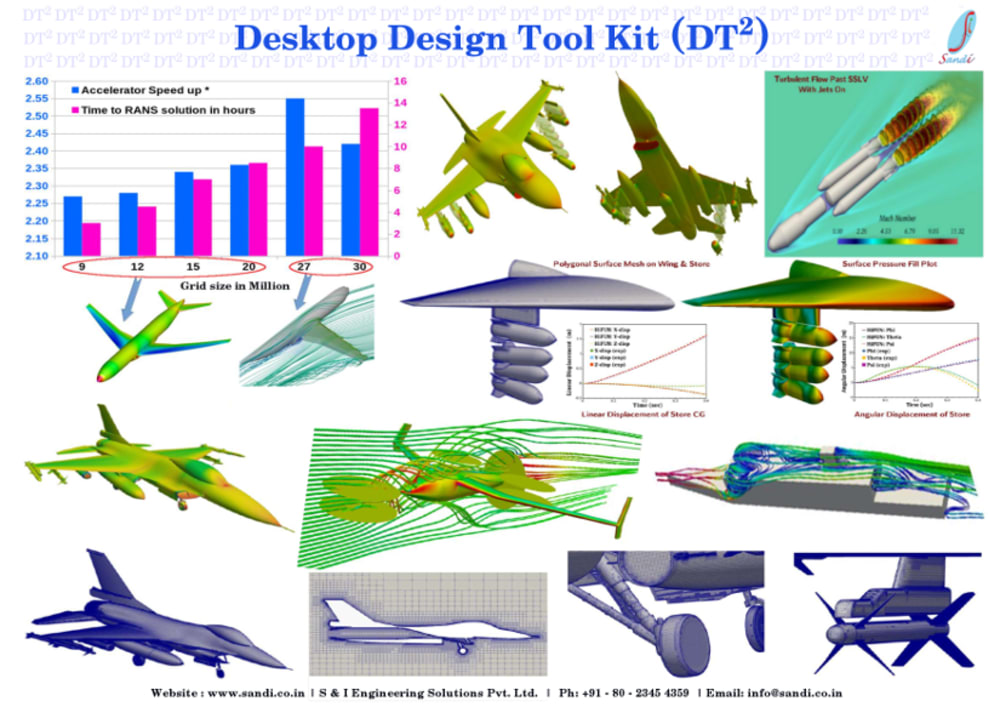Desktop Design Toolkit (DT2) is a Computational Fluid Dynamics (CFD) tool in the Computer-aided Engineering (CAE) arena. It caters to aerodynamic analysis of a system and/or its components in various engineering fields. It addresses entire spectrum of design & analysis cycle right from preliminary phase till final/detailed phase. DT2, on one hand, allows computationally intensive problems like RANS simulation of an aerodynamic system to be solved on a compact computing platform such as a dual-socket desktop computer with hardware accelerators like NVIDIA-GPU. On the other hand, DT2 imbibes a variety of low fidelity tools to perform a component-level analysis of an aerodynamic system on a modest computing platform such as a laptop. While DT2 meets the design needs of an established CFD user, it becomes a natural and easy choice for newer users with little experience in CFD.
In a design process, in tune with NASA’s CFD Vision 2030 study, DT2 automates the tedious tasks of aerodynamic analysis, improves productivity by enabling analysis of large number of design scenarios, saves time and money for model & prototype testing and enables other product improvements.
DT2 uses Cartesian mesh technology enabling process automation. Abilities of DT2 include: 1. Generating design data for aerodynamic characterisation of a system. 2. Carrying multi-body dynamic simulations using six degrees-of-freedom rigid body dynamics (RBD) solver. 3. Low fidelity enabled uncertainty quantification using Monte-Carlo technique. 4. Integrable with a flight controller module (FCM) to perform coupled CFD-RBD-FCM analysis.
Potential benefits of DT2: 1. Offers automation to generate aerodynamic data. 2. Requires just desktop-computer like computing platform with hardware accelerators like NVIDIA-GPU as against typical large scale supercomputers thereby reducing the hardware cost for the compute capability it delivers. 3. User may choose amongst various low and high fidelity methods for aerodynamic data generation based on resource constraints. 4. Makes CFD analysis affordable to all, ushering a new era of socialism in CFD. In essence, DT2 enables even smaller design houses with no access to high end CFD owing to the high costs of HPC platforms and CFD licenses, to rigorously employ CFD to meet their day-to-day design needs.
The software packaged in DT2 suite: 1. A Cartesian Mesher, 2. Highly scalable and data parallel Flow solver HiFUN-FS© , SandI’s proprietary tool, 3. Rigid body dynamics solver HiFUN-RBD©, SandI’s proprietary tool and 4. Open source Monte-Carlo module. The automation is achieved by a Python wrapper script. A user inputs data via a simple GUI developed in PyGTK. Most compute intensive part in DT2 is the software HiFUN-FS which uses MPI and OpenACC protocols to harness computing power offered by systems having multiple processor-cores and accelerators. Presently efforts are focused on development of Python wrapper script to automate aforementioned process.
DT2 finds its utility in many industries; Aerospace and Defence, Automotive, Transportation, Naval Aerodynamics, Wind energy, Industrial aerodynamics, to name a few. Therefore DT2 offers immense global market potential. For example, annual CFD revenue in Aerospace and Defence industry itself is few billion USA dollars.
Like this entry?
-
About the Entrant
- Name:Nikhil Vijay Shende
- Type of entry:teamTeam members:N. Munikrishna, Nikhil Vijay Shende, N. Balakrishnan,
- Patent status:none

